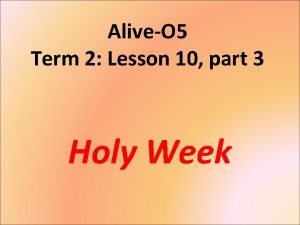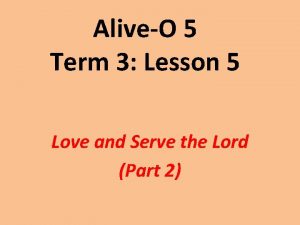AliveO 7 Term 1 Lesson 12 14 Moment












- Slides: 12

Alive-O 7 Term 1: Lesson 12 -14 Moment One, Day Four The Church Seasons

Liturgical Calendar

Seasons of the Year We usually think of a year as having the four seasons: Spring, Summer, Autumn, Winter. The calendar year begins in January, the time when the sun begins to rise earlier bringing longer days and ends in December, when the days are at their shortest.

The Church Year The Church year has seasons too. They follow the life, death and resurrection of Jesus.

Advent • The Church year begins with Advent, when we look forward to celebrating the birth of Jesus. • The liturgical colour for Advent is violet (purple). We will see this colour in the vestments worn by the priest and in the candles in the Advent Wreath. Violet is the colour representing preparation and penance. • The colour rose (pink) may be used on the third Sunday of Advent.

The Season of Christmas • The second season in the Church Year is Christmas, when we celebrate the birth of Jesus. This season begins on Christmas Day and ends with the Feast of the Baptism of Our Lord, on the first Sunday after January 6 th, the Feast of the Epiphany. • The liturgical colour for this season is white, the colour of celebration. • The colour red will be worn on some days during the season when the feast day's of martyrs are celebrated.

First Season of Ordinary Time The season which follows Christmas until Ash Wednesday is called Ordinary Time. This period of ordinary time is a season when we grow in our faith as a result of realising the great gift which Christ’s birth is to us. The liturgical colour for Ordinary Time is green, representing growth and new life.

Lent The season of Lent begins on Ash Wednesday and continues until Holy Thursday. This is the season during which we prepare to celebrate the life, death and resurrection of Jesus at Easter. The liturgical colour for Lent is violet, representing preparation and penance.

The Triduum We approach Easter through the Triduum of Holy Thursday, beginning with the Lord’s Supper through the suffering of Jesus on Good Friday and Holy Saturday leading into the celebration of the resurrection on Easter Sunday. The liturgical colours on the days of the Triduum are: Holy Thursday – White Good Friday – Red Holy Saturday (Easter Vigil) – White

Season of Easter The season of Easter begins from the Easter vigil (the eve of Easter Sunday) until Pentecost Sunday. The liturgical colour for the season of Easter is white.

Second period of Ordinary Time The second period of Ordinary Time begins the day after Pentecost Sunday until the first Sunday of Advent. The colour for this time is green, representing our growing in our relationship with God through our celebration of and participation in Jesus’ life, death and resurrection during the Easter Season.

Discussion • See the Consider Points on page 90 in the Teacher’s manual.
 Organization moment of the lesson
Organization moment of the lesson Organization moment
Organization moment Short, medium and long term planning in education
Short, medium and long term planning in education Term-to-term rule
Term-to-term rule Long term memory vs short term memory
Long term memory vs short term memory Quadratic sequence formula
Quadratic sequence formula Long term hr planning
Long term hr planning Position-to-term
Position-to-term Difference between long term and short term liabilities
Difference between long term and short term liabilities Accounting for serial bonds
Accounting for serial bonds Minterm and maxterm expansion
Minterm and maxterm expansion Nth term rule
Nth term rule Term to term rule
Term to term rule























